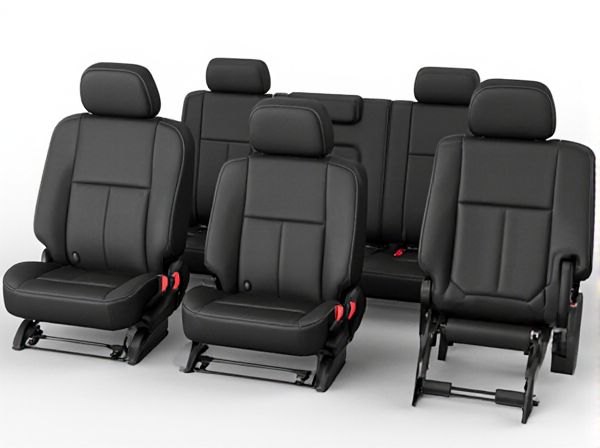
Photo illustration: Third-Row Seat vs Second-Row Seat
Third-row seats offer extra passenger capacity, ideal for larger families or group travel, while second-row seats typically provide more comfort and easier access for everyday use. Your choice depends on whether you prioritize seating flexibility or enhanced legroom and convenience. Vehicles with versatile seating arrangements allow you to switch between these options to suit different needs.
Table of Comparison
| Feature | Third-Row Seat | Second-Row Seat |
|---|---|---|
| Location | Rear of the vehicle | Middle of the vehicle |
| Passenger Capacity | 3 passengers (usually) | 2-3 passengers |
| Legroom | Limited space | More spacious |
| Accessibility | Less accessible, often requires folding second-row seats | Easy access without folding seats |
| Comfort | Typically less comfortable for adults | More comfortable, suited for adults and children |
| Use Case | Additional seating for larger groups | Primary seating with better comfort |
| Safety | May have fewer safety features | Usually equipped with advanced safety features |
| Storage Impact | Reduces cargo space when in use | Balances between passenger and cargo space |
Overview: Third-Row Seat vs Second-Row Seat
The third-row seat typically offers additional passenger capacity, accommodating up to three more occupants, making it ideal for larger families or group travel. Second-row seats provide more legroom and comfort, often featuring captain's chairs or bench-style configurations with easier access to front controls. Choosing between the two depends on prioritizing passenger volume or individual comfort and accessibility.
Seating Capacity and Flexibility
Third-row seats increase overall seating capacity, often allowing vehicles to accommodate 7 to 8 passengers compared to second-row seats that typically seat 2 to 3 passengers. These seats provide enhanced flexibility, as third-row seats frequently fold flat to expand cargo space, while second-row seats may slide or recline for passenger comfort. Vehicle configurations vary, but the inclusion of a third-row is essential for larger families or groups needing additional passenger space without sacrificing functionality.
Comfort and Passenger Experience
Third-row seats often provide less legroom and cushioning compared to second-row seats, impacting passenger comfort during long journeys. Second-row seats typically offer more space, recline options, and easier access, enhancing overall passenger experience. Vehicles with captain's chairs in the second row further elevate comfort by providing individual seating and additional armrests.
Accessibility and Ease of Entry
Third-row seats often present challenges in accessibility due to their position behind the second row, requiring passengers to fold or slide the second-row seats to gain entry. Second-row seats typically allow for easier and quicker access as they are positioned closer to vehicle doors, providing more direct entry and exit without maneuvering around other seats. Vehicles with features like adjustable sliding second-row seats or wide door openings enhance the ease of entry to both second and third rows, but overall, second-row seats remain more accessible for frequent use.
Legroom and Space Analysis
Third-row seats generally offer less legroom compared to second-row seats, making them more suitable for children or shorter trips. Second-row seats often provide greater space and comfort due to their primary passenger design, accommodating adults with enhanced legroom and recline options. Vehicle models like SUVs and minivans maximize second-row legroom, while third-row seats prioritize seating capacity over extended comfort.
Storage and Cargo Solutions
Third-row seats often fold flat to maximize cargo space, making them ideal for larger storage needs compared to second-row seats that typically slide or recline without fully folding. Second-row seats can offer versatile configurations such as split-folding or sliding mechanisms that provide easier access and partial cargo expansion without sacrificing passenger comfort. Vehicles with both second and third-row seating frequently feature underfloor storage compartments and adjustable cargo floors to optimize storage solutions in various seating arrangements.
Safety Features and Considerations
Third-row seats often include enhanced safety features such as side-impact airbags and reinforced seat structures to protect passengers in rear collisions, whereas second-row seats typically offer more advanced restraint systems like integrated child seat anchors (LATCH) and adjustable headrests for optimal neck support. Occupant safety in the third row can be influenced by reduced crash impact protection due to vehicle design constraints, making seat belt usage and proper seating posture essential. Evaluating crash test ratings and the presence of active safety technologies like seatbelt pre-tensioners is crucial when comparing the safety of third-row versus second-row seating positions.
Vehicle Types: SUVs, Minivans, and Crossovers
Third-row seats in SUVs and minivans provide increased passenger capacity, making these vehicles ideal for larger families and group travel, while second-row seats in crossovers often balance passenger comfort with easier access and cargo versatility. Minivans typically feature sliding second-row doors and spacious third-row seats designed for maximum interior space and accessibility. SUVs offer a range of configurations where third-row seats may be foldable or removable, optimizing cargo space without sacrificing seating flexibility compared to the more compact second-row layouts in crossovers.
Family and Lifestyle Needs
Third-row seats offer expanded passenger capacity, ideal for larger families needing to accommodate children and carpooling with friends, enhancing convenience during school runs and family outings. Second-row seats provide easier access and more comfort for children or adults, often featuring captain's chairs that improve space and individualized support for long trips. Choosing between third-row and second-row seats depends on balancing extra seating needs with everyday comfort, cargo space, and the family's lifestyle priorities.
Resale Value and Market Demand
Third-row seats significantly enhance a vehicle's resale value by appealing to larger families and buyers needing extra passenger capacity, often increasing market demand for SUVs and minivans. Second-row seats, while essential, do not boost resale value as much unless they include premium features like captain's chairs or enhanced comfort options. Vehicles offering flexible third-row seating configurations tend to outperform those limited to second-row accommodations in both market desirability and long-term value retention.
 caratoz.com
caratoz.com